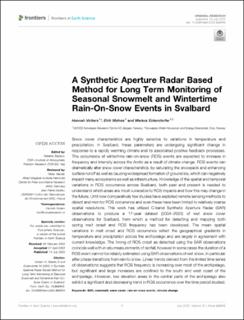| dc.contributor.author | Vickers, Hannah | |
| dc.contributor.author | Malnes, Eirik | |
| dc.contributor.author | Eckerstorfer, Markus | |
| dc.date.accessioned | 2022-08-17T07:07:56Z | |
| dc.date.available | 2022-08-17T07:07:56Z | |
| dc.date.created | 2022-08-16T15:13:31Z | |
| dc.date.issued | 2022 | |
| dc.identifier.issn | 2296-6463 | |
| dc.identifier.uri | https://hdl.handle.net/11250/3012235 | |
| dc.description.abstract | Snow cover characteristics are highly sensitive to variations in temperature and precipitation. In Svalbard, these parameters are undergoing significant change in response to a rapidly warming climate and its associated positive feedback processes. The occurrence of wintertime rain-on-snow (ROS) events are expected to increase in frequency and intensity across the Arctic as a result of climate change. ROS events can dramatically alter snow cover characteristics, by saturating the snowpack and enhancing surface runoff as well as causing widespread formation of ground ice, which can negatively impact many ecosystems as well as infrastructure. Knowledge of the spatial and temporal variations in ROS occurrence across Svalbard, both past and present is needed to understand which areas are most vulnerable to ROS impacts and how this may change in the future. Until now comparatively few studies have exploited remote sensing methods to detect and monitor ROS occurrence and even these have been limited to relatively coarse spatial resolutions. This work has utilized C-band Synthetic Aperture Radar (SAR) observations to produce a 17-year dataset (2004–2020) of wet snow cover observations for Svalbard, from which a method for detecting and mapping both spring melt onset and ROS frequency has been developed. The mean spatial variations in melt onset and ROS occurrence reflect the geographical gradients in temperature and precipitation across the archipelago and are largely in agreement with current knowledge. The timing of ROS onset as detected using the SAR observations coincide well with in-situ measurements of rainfall, however in some cases the duration of a ROS event cannot be reliably estimated using SAR observations of wet snow, in particular after phase transitions from rain to snow. Linear trends derived from the limited time series of observations suggests that ROS frequency is increasing over most of the archipelago, but significant and large increases are confined to the south and west coast of the archipelago. However, low elevation areas in the central parts of the archipelago also exhibit a significant and decreasing trend in ROS occurrence over the time period studied. | en_US |
| dc.language.iso | eng | en_US |
| dc.rights | Navngivelse 4.0 Internasjonal | * |
| dc.rights.uri | http://creativecommons.org/licenses/by/4.0/deed.no | * |
| dc.title | A Synthetic Aperture Radar Based Method for Long Term Monitoring of Seasonal Snowmelt and Wintertime Rain-On-Snow Events in Svalbard | en_US |
| dc.title.alternative | A Synthetic Aperture Radar Based Method for Long Term Monitoring of Seasonal Snowmelt and Wintertime Rain-On-Snow Events in Svalbard | en_US |
| dc.type | Peer reviewed | en_US |
| dc.type | Journal article | en_US |
| dc.rights.holder | © 2022 Vickers, Malnes and Eckerstorfer | en_US |
| dc.description.version | publishedVersion | en_US |
| cristin.ispublished | true | |
| cristin.fulltext | original | |
| cristin.qualitycode | 1 | |
| dc.identifier.doi | 10.3389/feart.2022.868945 | |
| dc.identifier.cristin | 2043523 | |
| dc.source.journal | Frontiers in Earth Science | en_US |
| dc.source.volume | 10 | en_US |

